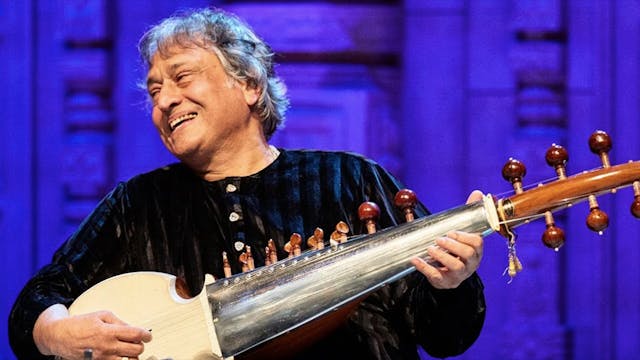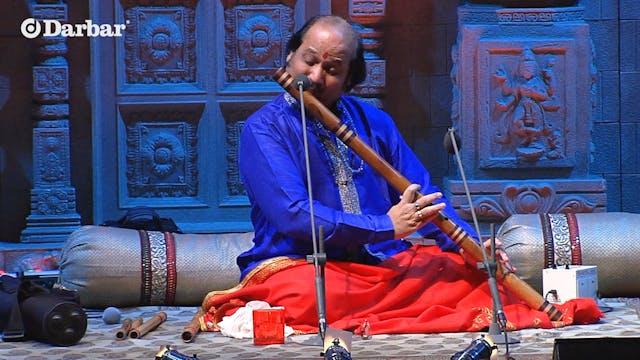Rakesh Chaurasia & Pandit Anindo Chatterjee | Raag Jog
Hindustani Instrumental
•
1h 0m
Recorded at Darbar Festival 2016, on 16th September, at Royal Festival Hall, at London's Southbank Centre.
Musicians:
- Rakesh Chaurasia (flute)
- Pandit Anindo Chatterjee (tabla)
Alap, Jod, Jhalla & a composition in Matta Taal
Raag Jog; Thaat: Kafi; Samay: Night
Raag Jog comprises one of the most enduring musical mysteries of all time in Hindustani classical music. Its meend-laden phrases and the chromatic use of the pure and flat 3rd (shuddh and komal Ga) is a heady combination that creates a trance-like state in the listener’s mind.
Acclaimed the world over for his superlative melodic mastery, sharp sense of rhythm and an astonishing ability to embrace, dive into and reinterpret music across wide range of genres, Rakesh Chaurasia’s approach to ragas is eclectic. In this concert from 2016, he presents an alap, jod, jhalla and a composition in Raag Jog.
Accompanying him on the tabla is the veteran from of the Farrukhabad gharana - Pandit Anindo Chatterjee - who is deeply respected the world over for solid aesthetics and his rich contributions to the gharana.
Chaurasia keeps the alap technically simple but breathes life into the phrases by interconnecting octaves through invisible threads between the phrases to weave layers of harmonies. He arranges the major and minor tonal sentences by pairing, intertwining and binding them with each other to create a grandiose structure of Jog.
He plays a madhyalay composition in a 9-beat cycle called Matta Taal. Pandit Chatterjee’s tabla accompaniment starts with a calm and easy delivery whereby he delves into the immersive intimacy created by Chaurasia. The intricately woven rhythmic phrases intersperse the spaces in between Chaurasia’s melodic discourse and are delivered with unparalleled technique and regal gait.
A pleasing and popular raga, Raag Jog is a more recent addition to the pantheon of Hindustani ragas – it is about one hundred years old. The most popular version of this raga employs both shudh and komal Ga (G and g) and komal Ni (n). It is similar to Raga Nattai in Carnatic Music. Jog is derived from Khamaj thaat and its jati is audav-audav. Its vadi swar is Ma and the samvadi swar is Sa. Jog omits Re and Dha (2nd and 6th) altogether from the scale. Its arohana and avarohana are as follows:
S G M P n S’
S’ n P M G M g S
The other version of the raga deploys shuddh Ni (7th) as well. The treatment of the raga, as visualised by Ustad Amir Khan, lays great emphasis on Ma (4th) that adds deeper shades of pathos to its intrinsic desolate mood. In recent times the chromatic use of both Ga is in vogue. This is not permissible in Hindustani classical music, but a judicious phrase is accepted as the ‘poet’s liberty’.
Up Next in Hindustani Instrumental
-
Pandit Budhaditya Mukherjee | Raag Lalit
Recorded on 13th October at the 2019 Darbar Festival, at the Barbican Centre, London.
Musicians:
- Pandit Budhaditya Mukherjee (sitar)
- Soumen Nandy (tabla)Raag Lalit; Thaat: Poorvi; Samay: Early Morning
-
Ust. Amjad Ali Khan, Pt. Kumar Bose &...
Recorded at Darbar Festival 2016, on 18th September, at the Royal Festival Hall, at London's Southbank Centre.
Musicians:
- Amjad Ali Khan (Sarod)
- Kumar Bose (Tabla)
- Anindo Chatterjee (Harmonium)Raag Shree; Thaat: Poorvi; Samay: Late Afternoon
Watch this unique performance by 3 of India's...
-
Pandit Ronu Majumdar | Raag Parameshwari
Recorded at Darbar Festival 2015, on 19th September, at the Purcell Room of the Queen Elizabeth Hall, at London's Southbank Centre.
Musicians:
- Pandit Ronu Majumdar (bansuri)
- Sukhvinder Singh (tabla)
- Kiruthika Nadarajah (tanpura)Raag Parameshwari; Samay: Late Morning
Watch this stunning ...



